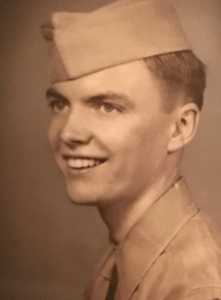Scroll of Honor – John Coleman Carlisle
Deadly Foe
Written by: Kelly Durham
By the time John Coleman Carlisle of Newberry checked into the barracks,  he probably knew already that his days on campus were numbered. Carlisle’s Clemson bore faint resemblance to the bustling college where just two years before one of the largest cadet corps in the country had marched across the green expanse of Bowman Field. By that fall of 1944, cadet gray had been largely replaced by Army khaki and green as activity on campus had switched from academic instruction to the training of Army engineers and pilots. As he walked the paths to his textile engineering classes, Carlisle would have encountered young Army officers on their way to military-oriented instruction in engineering, surveying and flying.
he probably knew already that his days on campus were numbered. Carlisle’s Clemson bore faint resemblance to the bustling college where just two years before one of the largest cadet corps in the country had marched across the green expanse of Bowman Field. By that fall of 1944, cadet gray had been largely replaced by Army khaki and green as activity on campus had switched from academic instruction to the training of Army engineers and pilots. As he walked the paths to his textile engineering classes, Carlisle would have encountered young Army officers on their way to military-oriented instruction in engineering, surveying and flying.
Upon completion of his freshman year, Carlisle enlisted in the Navy, undergoing basic training at Bainbridge, Maryland. His next assignment was aboard a ship in the Pacific theater of operations. By this point in World War II, American and Allied forces were tightening the noose around Japan. Victories at Iwo Jima and Okinawa put America’s state-of-the-art heavy bomber, the B-29 Superfortress, within range of Japan’s home islands. But, when Carlisle became ill, he found himself at nearly the opposite end of the great Pacific Ocean, on the island of Samoa.
Located 1,800 miles northeast of New Zealand and 2,600 miles southwest of Hawaii, Samoa was a backwater. The only enemy action there had occurred shortly after Pearl Harbor, in early January 1942 when a Japanese submarine had surfaced and briefly shelled the US Naval Station at Tutuila.
From a distance of nearly three-quarters of a century, it’s easy to forget how different life was in 1945. Radio—AM radio at that—was the only instant mass medium. People still wrote letters, drank Coca-Cola from glass bottles, and went to the movies every week, but the war was changing things, in part by accelerating discovery in many fields, from communications and aviation to medicine.
One of the more frightening diseases of the day was poliomyelitis–polio for short–which was considered primarily a childhood disease, with most cases occurring in children from six months to four years of age. Polio in these younger children generally resulted in mild symptoms—only one case in a thousand resulted in paralysis. And once afflicted, an individual developed an immunity to the disease. With steadily improving community sanitation, such as better sewage disposal and clean water supplies in developed countries, fewer infants and young children were exposed to the disease—and so fewer developed an immunity to the virus. As a result, many were not exposed to the virus until late childhood or early adult life—when one case in seventy-
five resulted in paralysis. The most notable example was President Franklin Roosevelt, who had contracted polio at the age of thirty-nine.
Major US polio epidemics began to be recorded in 1894, when one hundred twenty-six cases occurred in Vermont. Eighteen of the afflicted died. In 1907, twenty-five hundred cases of polio were reported in New York City. In 1916, there were 27,000 cases in the United States, six thousand of which ended in death. Each summer a polio outbreak occurred in some region of the United States, with the epidemics becoming more serious in the 1940s. Theaters and swimming pools closed and many people avoided public gatherings for fear of infection.
Ironically, in a post-war report by the US Army Medical Department, the rate of polio in the Army was comparable to that found in the population at large—despite living conditions, especially in combat zones, where sanitation was often primitive. The low incidence of polio among troops indicated that the disease did not behave like measles or mumps, which frequently appeared in epidemic form among batches of new recruits.
Polio occurred less frequently in Europe than in the Middle East or China-Burma-India areas of operations. It was rare in the Southwest Pacific theater, except for in the Philippines, and only ten cases were reported in the South and Central Pacific in 1945. But one of those cases was John Carlisle—who at eighteen was in the vulnerable age group. Carlisle died from polio on October 31, 1945 at Samoa. He was survived by his parents, his brother, aunts and uncles.
The Germans and Japanese were not the only deadly foes that would go down to defeat. With the introduction of Jonas Salk’s polio vaccine in the early 1950s, cases of the disease began to plummet. Efforts by organizations like Rotary International, the World Health Organization, US Centers for Disease Control and Prevention, UNICEF, and the Bill and Melinda Gates Foundation have been effective in battling polio. The last case of polio in the United States occurred in 1979. In 2015, there were only seventy-five cases worldwide, a reduction of 99.9% since the 1980s. Today, polio exists only in Afghanistan, Pakistan, and Nigeria.
For more information on John Coleman Carlisle, see: http://soh.alumni.clemson.edu/scroll/john-coleman-carlisle/
For additional information on Clemson University’s Scroll of Honor see: http://soh.alumni.clemson.edu/
